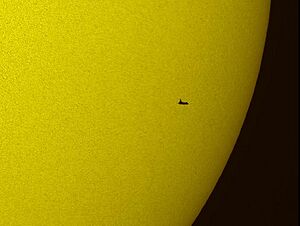Solar transit facts for kids

In astronomy, a solar transit happens when one object passes directly in front of the Sun. From our view on Earth, this means the object moves between us and the Sun. This can include planets like Mercury and Venus. You might have heard of the Transit of Mercury or the Transit of Venus.
A solar eclipse is also a type of solar transit. It happens when the Moon passes in front of the Sun. However, for something to be called a "transit," the object usually needs to appear smaller than the Sun's disc. So, a total solar eclipse, where the Moon completely covers the Sun, isn't technically called a transit. But an annular eclipse, where the Moon is smaller and leaves a ring of sunlight, fits the definition better. Solar transit is just one kind of astronomical transit.
Solar transit also affects communications satellites. This event is often called a solar outage or sun fade in the world of satellites. It happens when the Sun lines up directly behind a satellite from the perspective of an Earth station (a dish on the ground).
Contents
Why Do Satellites Have Sun Outages?
The Sun is incredibly powerful. Besides light, it sends out a lot of microwave radiation. When the Sun is directly behind a satellite, this strong microwave radiation can overwhelm the weaker radio signals coming from the satellite. Think of it like trying to hear a whisper when someone is shouting very loudly next to you!
This powerful electromagnetic interference causes problems. It can interrupt services that use satellite dishes. This includes TV networks, radio networks, and even some internet services like VSAT and DBS. These interruptions usually last for a few minutes each day. They happen for several days in a row, especially around the equinoxes (spring and autumn). The exact dates depend on where the satellite is in the sky compared to the Earth station.
How Signals Are Affected
Only signals coming down from the satellite to Earth (called downlinks) are usually affected. Signals going up from Earth to the satellite (called uplinks) are normally safe. This is because the Earth itself "shades" the Earth station when viewed from the satellite. So, the Sun's interference doesn't reach the uplink signal.
Satellites in geosynchronous orbit (which stay over the same spot on Earth) are affected in different ways depending on their exact path. Satellites in other orbits might be affected often, but only for a very short time. Services like GPS (Global Positioning System) and some satellite radio systems are not affected by solar outages. This is because they don't use large receiving dishes that focus the interference. Also, GPS uses satellites that are not in geosynchronous orbit.
What Happens During an Outage?
A solar transit outage starts with a brief drop in signal quality. This might last only a few moments. Then, at the same time each day for the next several days, the signal loss gets longer and worse. After a few more days, it gradually improves.
For digital satellite services, there's something called the "cliff effect." This means the signal either works perfectly or it disappears completely. There's no in-between. Typically, you might lose reception for only a few minutes on the worst day. How long and how bad the outage is can depend on the size of your satellite dish and the Signal strength of the signal. If a signal's power is focused into a narrow band, it has a higher signal-to-noise ratio. This means the signal is clearer compared to the background noise.
When and Where Do Solar Outages Happen?
The exact days and times for solar transit outages are different for each satellite and each receiving location on Earth. You can often find this information on various websites.
In the Northern Hemisphere, solar transit outages usually happen in early March and October. In the Southern Hemisphere, they typically occur in early September and April. The time of day for the outage mainly depends on the longitude (east-west position) of the satellite and the receiving station. The exact days depend more on the station's latitude (north-south position). Earth stations located near the equator will experience solar transit right around the equinoxes. This is because geostationary satellites are positioned directly above the equator.
How Do Networks Prepare?
Broadcast networks, like TV and radio stations, know when these solar transit outages will occur. To avoid interruptions, they have to plan ahead. They might pre-record their shows, switch to local programming, or get their signal from another satellite in a different orbital position. Sometimes, they use a completely different way to get the signal during these times.
See also

